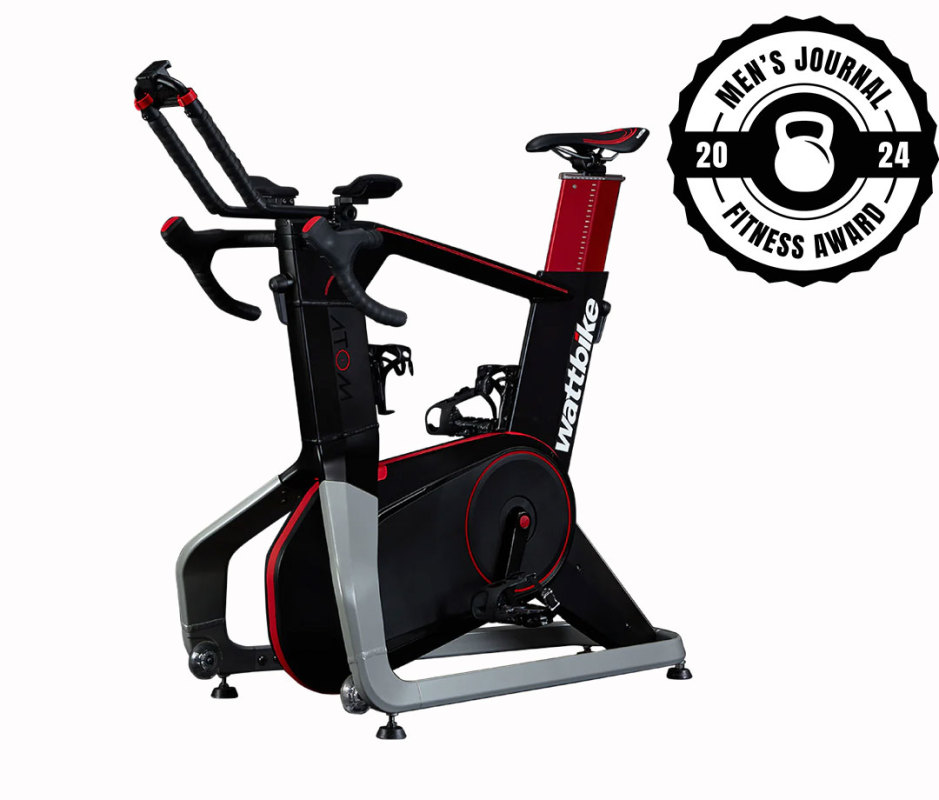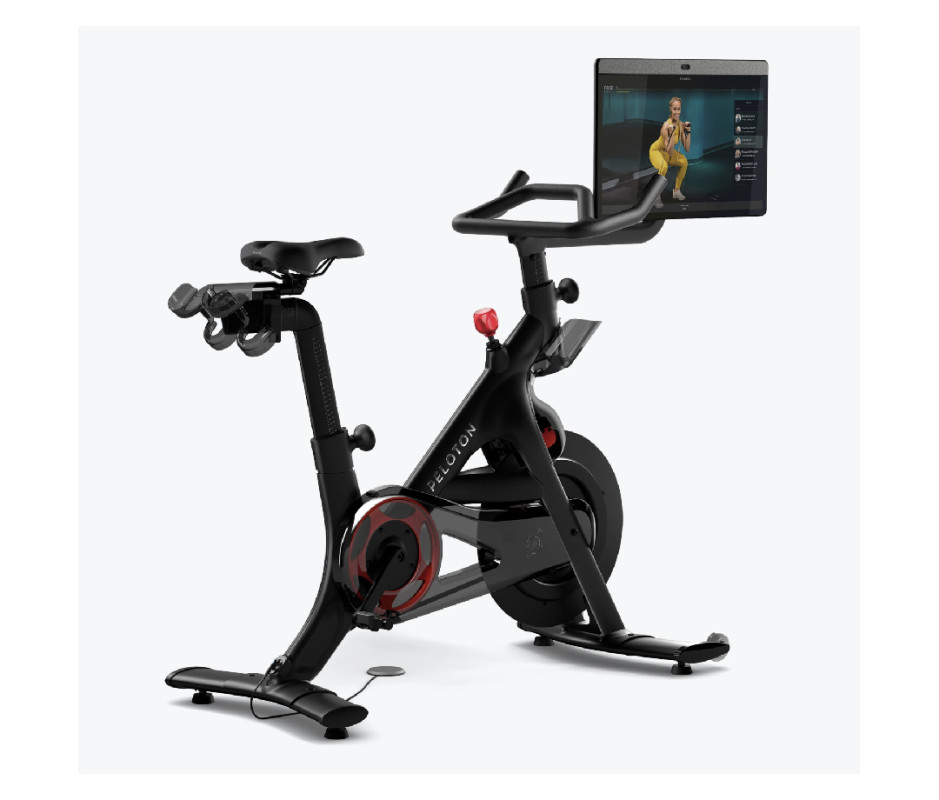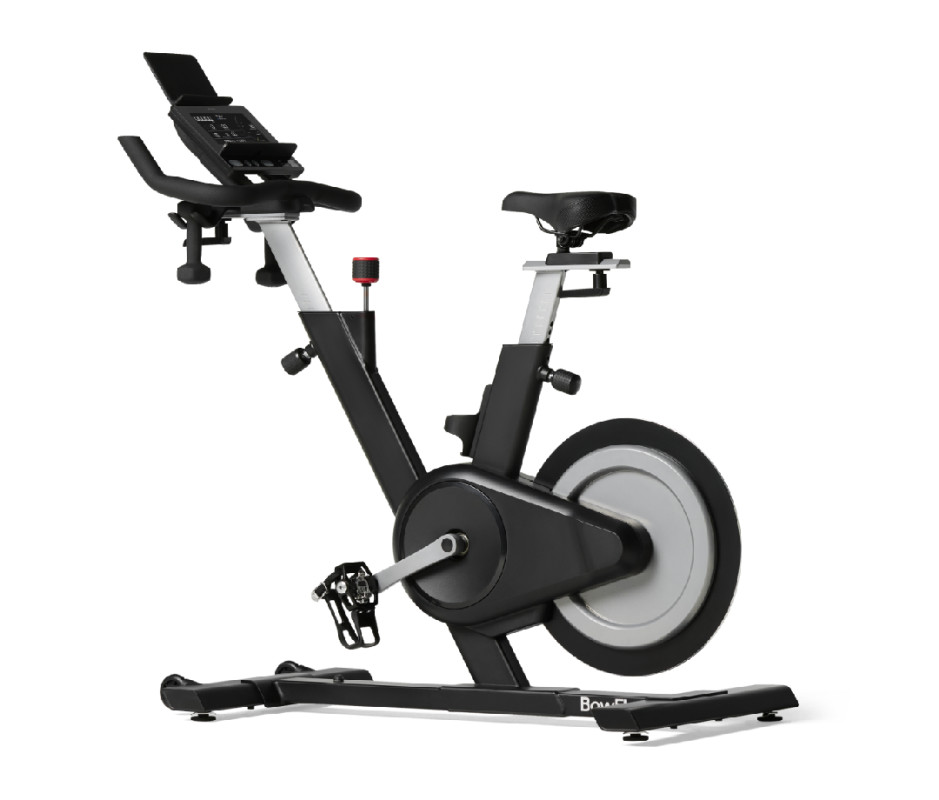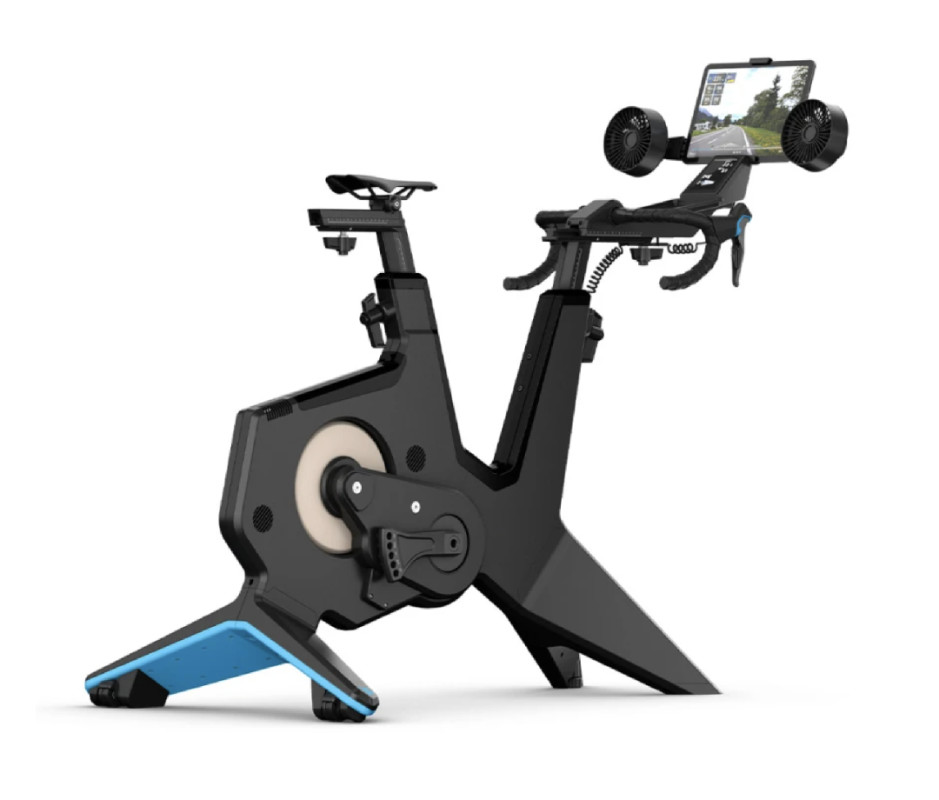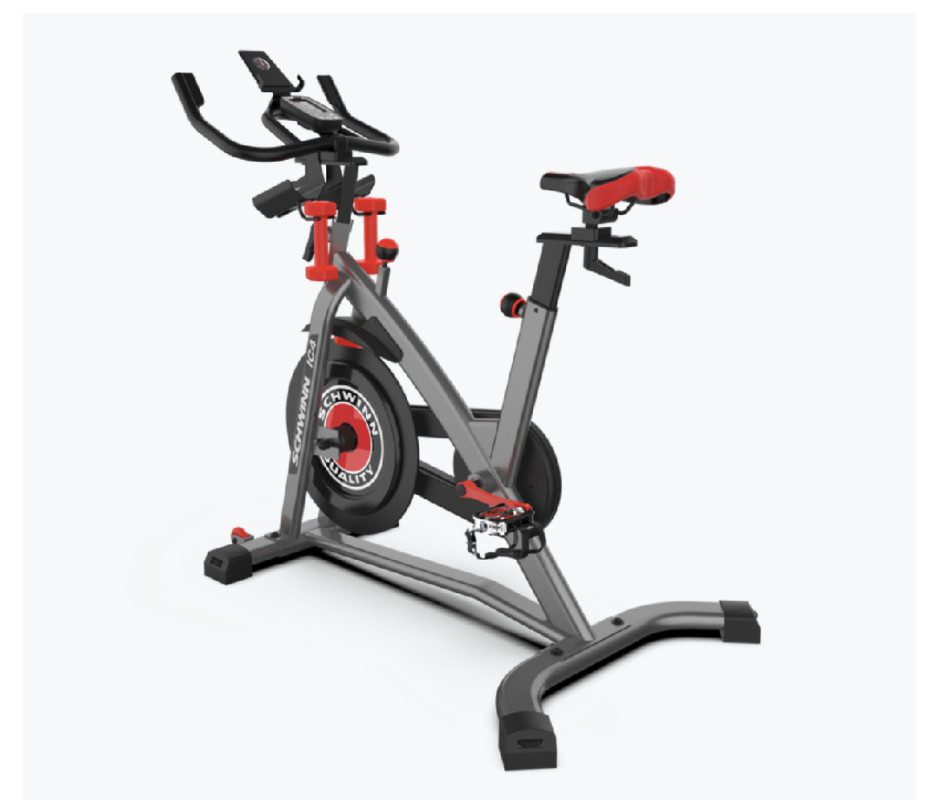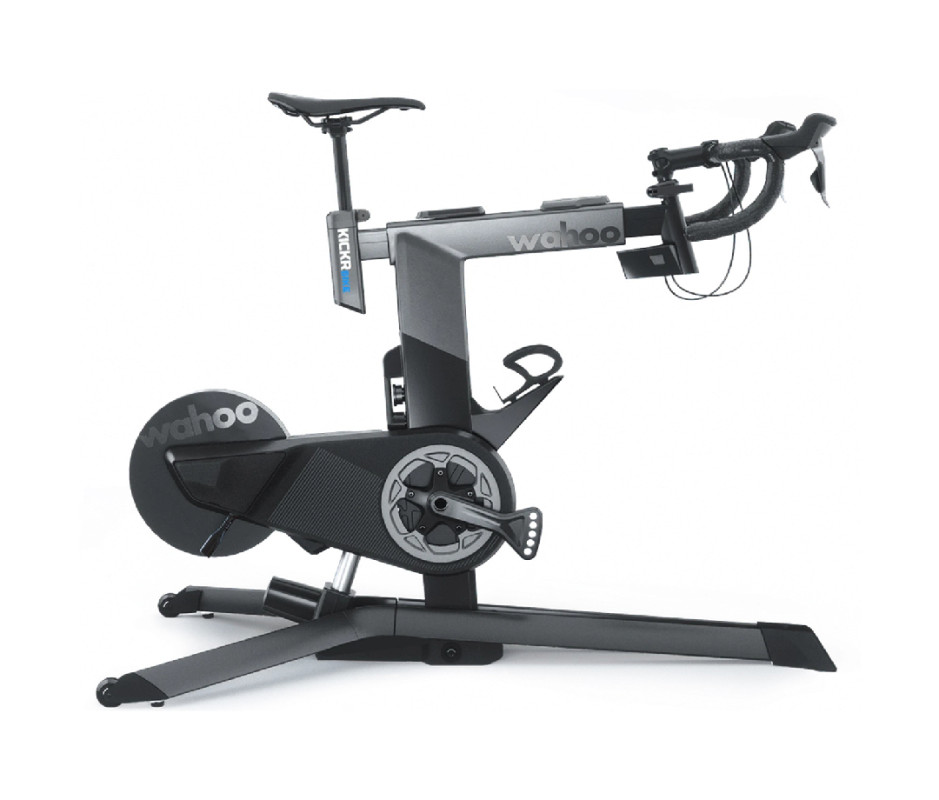Health
The Best Exercise Bikes for Your Home

Exercise bikes are enjoying a resurgence thanks to a recent explosion in available technology. Unlike their 1990s ancestors, most of today’s stationary indoor exercise bikes immerse you in classes, virtual reality rides, and game-like apps that make riding to nowhere far more fun than in decades past. They also can display and collect a lot of data about your efforts which can help you train smarter and provide real-time feedback that helps keep you engaged with the workouts.
Finding the right exercise bike (and the accompanying software to enhance your rides) can be a powerful way to fit fitness into a busy life when weather, time, and circumstances conspire to push your workouts into that eternal “tomorrow.” Picking a bike that meets your goals and needs will also ensure you keep coming back for workouts—lest it be relegated to acting as an expensive drying rack. Which is why our top pick for best overall home exercise bike is the Wattbike Atom. It’s a well-built bike that’s an all-around great smart trainer that includes compatibility with lots of apps.
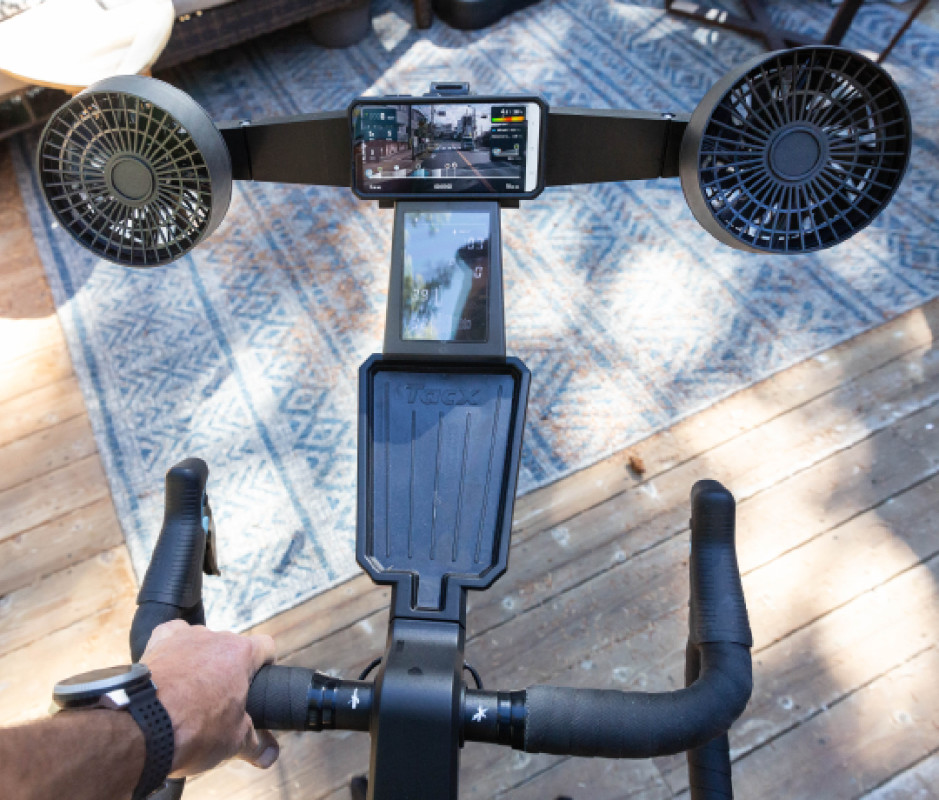
Justin Park
Related: 20 Best Exercises for Every Muscle, According to Science
For these reviews, we tested several of the most popular stationary exercise bikes in a range of prices and styles to share the pros and cons of each. Read on to learn more about the best indoor exercise bikes available today and find the trainer that best fits your budget and workout preferences so it gets covered in sweat instead of dust.
Men’s Journal aims to feature only the best products and services. We update when possible, but deals expire and prices can change. If you buy something via one of our links, we may earn a commission.
Best Overall Exercise Bike: Wattbike Atom
Courtesy Image
When researching indoor cycling bikes for this article, the Wattbike wasn’t on my radar at first. But as I talked to serious cyclists, the Wattbike kept coming up as a detail-oriented bike with a mid-range price beloved by racers and athletes for its serious training applications. Despite its “hardcore” rep, the bike itself is fairly unassuming and looks similar to other higher-end indoor trainers with road bike style handlebars, a performance seat, and lots of fit adjustment points. It’s also one of the few bikes that comes fully assembled which cuts out a huge hassle on the front end of your indoor bike experience. Fitting the bike is easy and the seat and handlebars move in several planes to dial in a comfortable fit—key to enjoying all those miles you’re going to log.
This is a fairly straightforward bike in terms of bells and whistles. Incline adjusts virtually, there are no Bluetooth fans, no built-in screen, and no little dumbbells hanging from the frame. The Atom sets itself apart by focusing on metrics and ride feel instead, making it a straightforward training tool for athletes and recreational riders.
The free Wattbike Hub app just looks science-y and I found the pedal efficiency visual display entrancing and addictive. Even though I’m a rider chasing fun and not at all obsessed with efficiency and KOMs, I found myself immediately battling to smooth my pedal strokes and balance right, left, push, and pull and could see how this gamification of technique could translate to real-world results. The Hub app also includes several benchmark tests that make it easy to get baseline fitness metrics for yourself and then check your progress as you train by taking the tests again.
While the accuracy and training features appeal to serious riders, the bike easily pairs with popular studio apps like Peloton and virtual ride apps such as Zwift, so it’s great for sharing with household members with different indoor training styles. There’s no built-in screen, but the tablet/phone holder makes it straightforward to get set up for virtual rides.
Even if you’re not going to use 100 percent of its capabilities, the Wattbike is a great all-around smart trainer that’s a less expensive option for riders that want accuracy, excellent compatibility with a wide range of apps, and a quality build. The price point might still be intimidating if this is your first indoor cycling bike, but if budget allows, it’s a bike that you can grow into unlike cheaper options whose limitations become apparent quickly.
- Flywheel weight: NA, electromagnetic resistance
- Max resistance: 2,500 watts
- Total weight: 105 pounds
- Built-in screen: No
Best Budget Exercise Bike: Merach S09 Indoor Bike
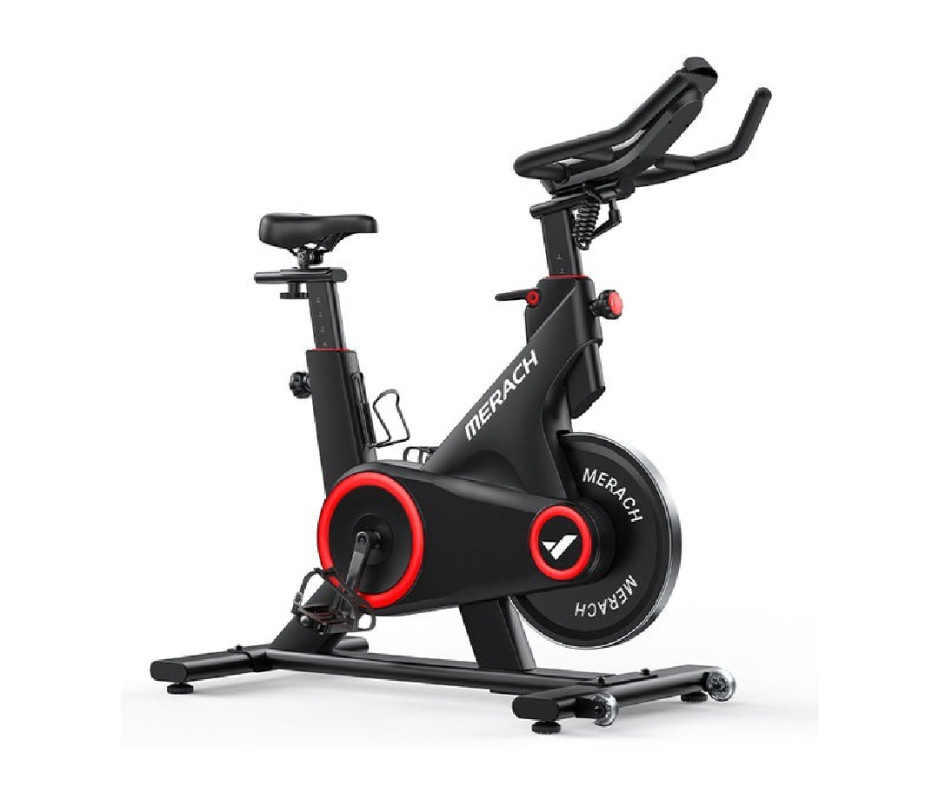
Courtesy Image
Merach’s S09 Indoor Exercise Bike gives you the most important features of the $4,000 bikes for less than $500. If you’re new to indoor cycling bikes, spending on the high end of the spectrum can be a pricey gamble, so the Merach S09 is a wallet-friendly way to test the waters. The 35-pound flywheel with electronically controlled magnetic resistance does a solid job replicating real-world riding and it’s nearly as quiet as the bikes from the big name companies. There’s no screen included which keeps the cost down and simplifies setup, but you’ll need to bring in a phone or tablet for virtual riding apps and there’s a phone/tablet holder built-in at eye level.
The bike has several tool-free fit adjustments that let you move the handlebars and seat fore and aft and up and down to get a comfortable fit and change the fit so multiple people can use the same bike. However, if you’re used to riding a nice outdoor bike, you may want to swap out the Merach’s pedals and seat for more performance options. The pedals have cages on one side and SPD clip-in cleats on the other. Likewise, the seat isn’t bad but will feel clunky if you’re used to slimmer saddles.
Importantly, the S09 played well with all the apps we used in testing. Zwift booted up and connected to the app with no hiccups and while you don’t get all the same features such as incline changes found in pricier options, the basic experience is there. There’s also the free Merach app which lets you get a taste of studio-style classes. It’s no Peloton app, but it’s not bad to mix into your routine and it’s a no-cost way to get started with apps. Hardcore riders may miss seeing their watts output, as the Merach just displays distance, cadence, time, and a calories burned estimate.
Might you like the $4,000 bikes better? Sure, but if you’re new to the category, this is a great starter bike to find out if you’ll stick with the habit and you can always upgrade to something shinier later. With registration, you get a two-year warranty, which is good reassurance for a budget bike.
- Flywheel weight: 35 pounds
- Resistance levels: 16
- Total weight: 95 pounds
- Built-in screen: No
Related: The Best Sport Watches for Every Type of Adventure
Best Exercise Bike for Spin Classes: Peloton Bike+
Courtesy Image
Peloton is the standard when it comes to studio-quality indoor bikes geared towards spin classes. While you can use the Peloton app with other bikes, only a Peloton Bike will let you compete on the Peloton leaderboards, and if you’re into Peloton classes, there’s no better bike to maximize your experience. Our tester felt that the bike itself, which includes an under-seat rack for lightweight dumbbells, was solid but that the software is what really makes the experience here.
Setting up these types of bikes can be a hassle if you’re operating solo or just not particularly handy, so we appreciated that Peloton sends a team with your delivery to bring the bike into your home and tackle all the assembly and initial setup. Fitting the bike is straightforward, but our taller tester wished you could adjust the reach on the handlebars instead of just the height. Likewise the large 24-inch monitor spins but isn’t otherwise adjustable to optimize your angle while riding. Clip-in pedals are included but you’ll need clip-in bike shoes if you don’t already own them, or swap in alternate pedals if you want to use regular shoes.
The Peloton app is front and center here and it stands out for the sheer breadth and depth of content available. There are thousands of classes on offer and not just for the bike. You can find instructor-led content for yoga, stretching, cardio, strength, running, Pilates, and more. Our tester noted that it’s easy to browse classes and find instructors and class types that fit your schedule and preferences. You’re locked into the Peloton app here, so no Zwift, TrainerRoad, or any of the other fitness or cycling apps while on the Peloton Bike+, but they include an entertainment mode that lets you play content from other apps such as Netflix, Disney+, and NBA League Pass while keeping your ride metrics in a helpful sidebar.
If you know you love Peloton classes already, picking up the Bike+ is a fairly easy choice despite the higher price for the bike and the $44 per month cost for their All-Access Membership. If you’re interested in Peloton but hesitant to make the investment, there are few ways to dip your toes in their pool. First, there’s a free tier to their app which will give you access to a small but representative sampling of their classes, even if you won’t be able to test it with the bike unless you live near their New York City studio. Luckily they also offer a risk-free 30-day trial of the bike. Peloton will deliver and set up the bike, you try it for up to 30 days, and if you decide it’s not for you, Peloton will refund you your cost including shipping fees and come pack up and take away the bike. Read our full review of Peloton Bike+.
- Flywheel weight: 38 pounds
- Resistance levels: 100
- Total weight: 140 pounds
- Built-in screen: Yes
Best Budget Peloton Alternative: Echelon Connect EX-5S-10 Bike
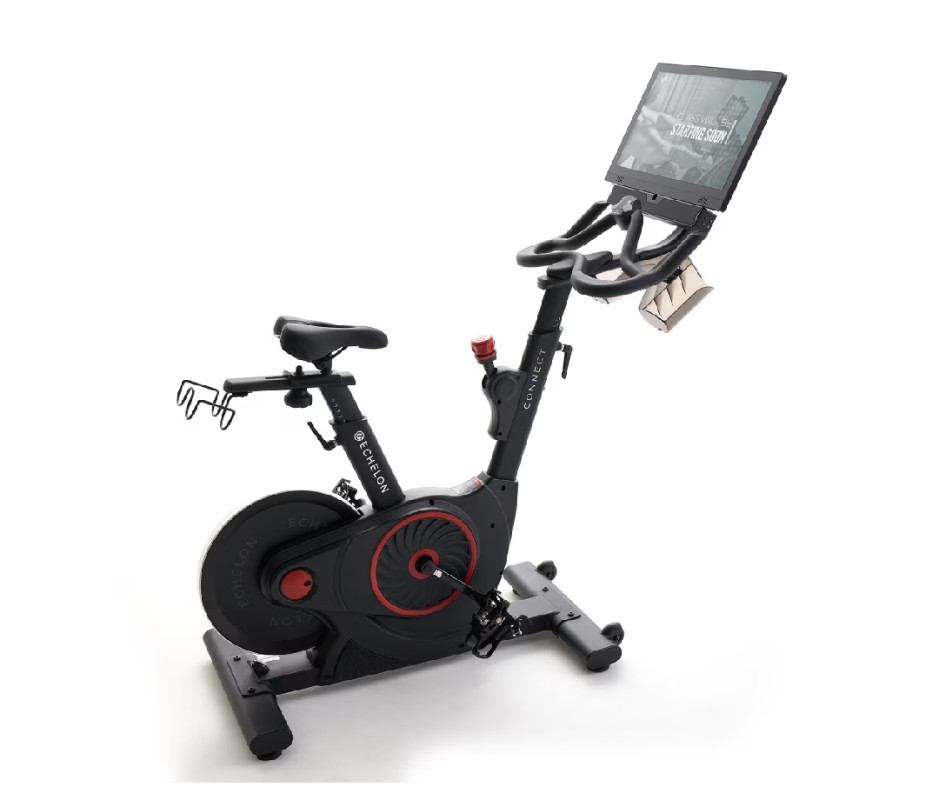
Courtesy Image
Peloton may set the standard for virtual fitness class libraries, but there are more options than ever in this space and many of them, like Echelon, come very close to matching the Peloton experience.
Echelon has thousands of classes, including live options to join and leaderboards to compete on, just like Peloton. They also have a diverse offering of off-bike classes, making the purchase of one of their bikes a more complete fitness solution than simply an at-home cardio machine.
Their Connect EX-5S-10 Bike can be had for about $500 less than Peloton base bike (and roughly $1,500 less than the Bike+), making it an attractive option for folks that want to get motivated by the social app-based class environment, but aren’t sure it’s worth it.
But is the Echelon bike and accompanying Echelon app any good? Our tester took advantage of the free 30-day trial and loved that there were plenty of options for choices in music, instructors, ability level, duration, and more. Unlike the bike, the cost for the app isn’t much cheaper than Peloton at $40 per month, but the savings on the bike versus the Peloton Bike+ could buy you several years of the Premier plan on the Echelon app. With the single subscription, you get up to five distinct user profiles, and our tester liked that he and his fiancee could share one subscription while still having distinct experiences.
Despite being a budget option, the EX-5S-10 comes with a 22-inch screen that’s large enough for easy viewing without making the bike top heavy or too much of a distraction in a room. Like Peloton, you’re locked into the Echelon app here so no Zwift or other fitness apps (no Peloton either, of course), but you can access music and a few other entertainment options.
Our tester discovered a backdoor that lets you load other apps such as Zwift and run them on the Echelon screen which gives you a lot more options for the bike. This light “hack” doesn’t require you to be a computer programmer, but it’s not exactly an approved use of the bike and there’s no guarantee Echelon won’t find a way to close this backdoor in the future.
In addition to the usual basics of RPMs, calories burned and the like, the bike also measures your power output in watts, a metric usually left out by budget bikes. This gives you a more objective riding metric to monitor and opens up more advanced cycling training rides that usually center around specific levels and oscillations of power output.
Overall, the Echelon Connect EX-5S-10 delivers most of what you get in a Peloton experience at a fraction of the cost. If you’re already a Peloton devotee, that might not be enough to sway you, but if you’re new to studio class-driven indoor cycling, Echelon is a great budget option to spin at home for less.
- Flywheel weight: 29 pounds
- Resistance levels: 32
- Total weight: 124 pounds
- Built-in screen: Yes
Best High-End Peloton Alternative: NordicTrack S27i Studio Cycle
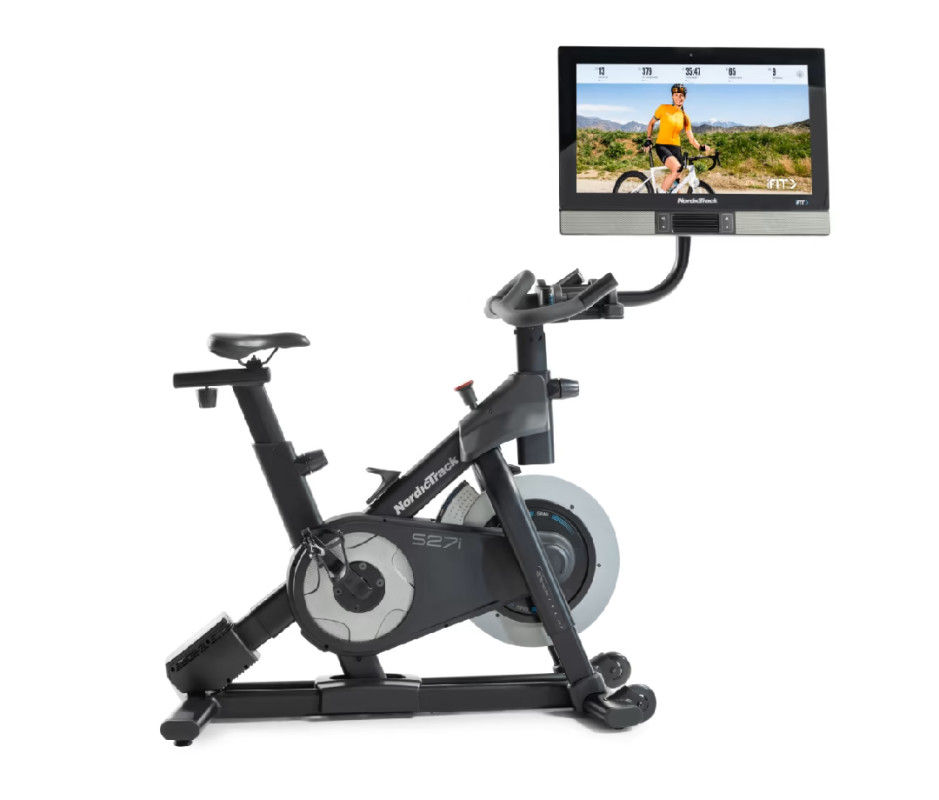
Courtesy Image
It can seem like the Peloton bike is your only option if you’re looking for an indoor bike with a focus on studio spin classes, but there are actually a surprising number of options in this space, including NordicTrack’s S27i paired with their own iFIT content.
The bike itself features thick, easy-to-grip handlebars that make several riding positions possible and it also comes with decent pedals that have cages on one side and clip-in SPD pedals on the other. One feature not found on most other studio bikes is the incline adjustment that tilts the bike up and down to simulate grades from 20 degrees uphill and -10 degree decline. The gradients definitely changed the ride experience and added realism while following virtual road rides on the screen, but more minor slope changes obvious in the video weren’t always reflected in gradient changes on the bike and there was often a lag.
The screen is massive, which makes the virtual rides more immersive, though adjusting the screen position was sometimes a challenge. The downside in our tiny home was that it made the big feel like it took up much more space in our living room than the other bikes I tested and it made the S27i feel like the focal point of the room at times. Folks who have space in a home office or basement likely won’t be as bothered by this, but for those who keep their indoor bike front and center, it might be worth considering the NordicTrack S22i which is essentially the same bike with a smaller screen.
Like the Peloton bike, the S27i is a ready-to-ride, complete indoor biking solution that offers a magnetic resistance bike with under-seat 3-pound dumbbells and a very large built-in screen that runs the iFIT interface. Like Peloton, you’re locked into the iFIT environment, so while we’re reviewing bikes here, the iFIT membership is a key feature to consider if you’re looking at any of the NordicTrack bikes. iFIT pushes you towards the $39 per month family membership, but there is an individual membership for $15 per month that is plenty for your one bike if you’re the only rider or if you aren’t concerned with the app tailoring workouts to you.
Compared to Peloton, there aren’t nearly as many studio classes, but the production level is high, as is the energy of the instructors. I especially enjoyed the highly-produced, guided virtual rides that took me from Iceland to Switzerland to Thailand to Nevada in the span of a week. The instructors are knowledgeable and they share asides about the locations as well as training tips that enhance the experience. The number of virtual real-world rides is one of the biggest differentiators between iFIT and the Peloton platform. My partner who prefers studio classes to virtual rides liked the iFIT app and NordicTrack bike best of all the bikes I brought into the house for testing.
While this bike and the iFIT platform combination are a worthy Peloton alternative, I’d love to see NordicTrack add entertainment, like Peloton, or even better, allow third-party apps such as Zwift.
- Flywheel weight: 32 pounds
- Resistance levels: 24
- Total weight: 217 pounds
- Built-in screen: Yes
Related: 15 Best Cheap Tequilas to Enjoy on a Budget
More Exercise Bikes We Love
Best Exercise Bike for Small Spaces: Bowflex IC Bike SE
Schwinn and Bowflex are owned by Nautlius and you can see similarities between the Bowflex IC Bike SE and the Schwinn IC4 I reviewed, but the IC Bike SE stands out for its minimalist design that has a similar footprint to other bikes but is easier to store in cramped spaces thanks to the streamlined V design. There’s still a fairly wide base for stability, but there’s less frame down low so you can tuck it up against other furniture and it’s easier to wheel around a room for stowing away or bringing it out for a ride.
The bike itself is quiet and pedals smooth yet still has 100 levels of resistance, which at the high end can challenge all but the most hardcore cyclists. The seat isn’t hard like higher-end bikes and is a good option for multiple users in a household, though serious cyclists will probably end up swapping it for something more like their outdoor bike saddles. Similarly, the combination cage/SPD clip-in pedals work well for multiple users, but you can swap pedals for a minor additional cost to mimic you outdoor bike setup.
You get classic exercise bike stats such as calories burned, distance, and time, but I wish power (in watts) was captured as it’s a key stat for many of the cycling apps such as Zwift. That said, the IC Bike SE plays well with most cycling apps so you can enjoy virtual rides even if you might not get the same experience as more fully featured bikes with higher price tags. It’s also great for studio cycling rides and Bowflex/Schwinn has their own JRNY app which has lots of workouts tailored to their equipment as well as classes you can take without owning a bike or treadmill. I’ve noted before that I’m not much of a workout class person as I find I don’t need the interactivity to work out, but the JRNY workouts were well-produced and my class-loving partner enjoyed them.
The built-in 7-inch display is nice but I wish they would’ve used that screen to give you a tablet-like app interface instead of just an oversized display for your basic stats. Nearly half of the screen is devoted to a meter that shows your estimated calories burned. The small shelf above the screen works to place a tablet, phone, or even laptop, but I found that if I was really pushing hard, I could easily knock my device off since there isn’t a way to lock it in on the platform.
- Flywheel weight: NA
- Resistance levels: 100
- Total weight: 135 pounds
- Built-in screen: Yes
Best Smart Exercise Bike: Garmin TacX Neo Bike Plus
As a mountain biker that likes indoor training mostly to prepare for outdoor rides, I preferred the TacX Neo Bike Plus out of all of the bikes I tested. Along with the Wahoo Kickr Bike, this is as high-end as it gets when it comes to smart indoor cycling bikes, but the price buys you a lot of really nice features if you can afford it. When paired with Garmin’s TacX Training App, Zwift, and other apps, the bike becomes as close to a virtual reality ride experience as you can get in your home.
So how is this bike different than $500 options that seemingly operate in basically the same way? There are some obvious hardware features that stand out. The first difference I noticed is that there’s a virtual freehub, as on most outdoor bikes, which lets you coast for recovery on descents. On most other indoor bikes, if you try to coast (and you will if you ride outside), the pedals’ momentum will continue and whip your feet around. This may sound like a minor thing on paper but it adds a lot to the realism of your virtual rides.
Another surprisingly welcome feature is the simulated road feel. While not unique to the Garmin bike, this capability sends a diverse array of tactile vibrations through the bike when riding over virtual gravel, cobblestones, bridges, and dirt. When testing, I hadn’t read the features closely enough to expect it and was taken aback when I crossed my first wooden bridge in Zwift and found that it felt like I was crossing a wooden bridge. There are also built-in fans that can be configured to blow on you in proportion to your speed which helps cool you down and adds a little more to the realism. You can move the fans around as well if you don’t need them right in your face.
All that said, this is still a stationary bike. If you’re grunting out a climb outdoors, your bike rocks side to side and the Garmin doesn’t do that (yet). It also only simulates gradient virtually via resistance changes while many bikes including the Wahoo Kickr actually tilt your bike up and down which more accurately mimics the body and bike positions when gradients change. Having tested the dynamic incline feature on several other bikes, the omission here didn’t break my heart. I’ve found this feature fun when it works well, but it can lag behind the changes on-screen which breaks the virtual spell. For $4,000, it seems like something Garmin should try to tackle, but if it doesn’t work perfectly, I’d rather not have it at all.
You can pair the TacX Neo Bike Plus with the Garmin TacX Training app, Peloton, Zwift, TrainerRoad, and pretty much any cycling app on the market and Garmin seems to have put in the work to ensure smooth compatibility. The TacX Training app isn’t included and it’s optional to use with the TacX bike, but it offers virtual rides from around the world. These rides give you a first-person virtual view of the terrain and include simulated road feel feedback. I prefer these rides to hosted rides I’ve tried on other platforms where a guide leads you and talks the whole time. You simply experience the ride and can focus on the experience, though it might feel barebones to folks that prefer the interactions, badges, and other augmentations in virtual cycling worlds. You can also create and follow your own routes anywhere that Bing or Apple Maps cover, which isn’t quite as visually compelling, but can be a great training tool if you have a particular course you want to train for.
The biggest downside here is cost. The price tag is high and you’ll need to add pedals, app subscriptions, and a device for viewing virtual content at minimum. The costs mean that this bike isn’t realistic for any but the most devoted cyclists, but for those with the budget and the internal drive to get their money’s worth, the TacX Neo Bike Plus delivers the next best thing to riding outdoors.
- Flywheel weight: NA, virtual
- Resistance: 2,200 watts max
- Total weight: 110 pounds
- Built-in screen: No
Best Exercise Bike Under $1,000: Schwinn IC4 Indoor Cycling Bike
While the Schwinn IC4 technically retails for $1,300, it has been out for a few years now and can be had online from multiple retailers for well under $1,000, making it a great value option that fits both studio class enthusiasts as well as virtual cycling racers. It’s super-quiet and easy to use, making it an option for those just looking for an affordable bike to log cardio, with or without app enhancement.
For a budget bike, the substantial 40-pound flywheel provides plenty of magnetically controlled resistance via a front-and-center manual knob. Because it’s manual instead of electronic, you don’t get a data output or screen display of resistance and instead have to go by feel, or Rate of Perceived Exertion if you want to use the exercise parlance for “how hard exercise feels.” The pedals are fine, offering SPD clip-in or cage but you’ll likely swap these out if you have preferences from your outdoor bike. The seat is a nice surprise for a budget bike, offering a slimmer performance style build that’s not too cushioned but also not race bike hard.
You get all the usual stats such as distance, time, (estimated) calories burned, and RPMs, which is helpful when following along in spin classes. Probably the biggest omission is power, which is nice to have for many of the virtual riding apps and training programs though they will usually estimate watts based on the resistance. The backlit LCD display just gives you the basics, but there’s a phone/tablet holder for app viewing. Schwinn’s own JRNY app isn’t included, but it pairs nicely with the bike and you can use the generous 60-day trial to see if the classes fit your workout style.
The bike also has racks for the included 3-pound dumbbells incorporated into many of the studio classes. For larger guys like myself, such tiny dumbbells feel like an unnecessary bonus but they didn’t get in the way. Much more useful and surprising is the included heart rate monitor armband which transmits your heart rate data to apps and is a useful gauge of exertion in lieu of metrics such as wattage.
Compared to pricier bikes, the Schwinn IC4 keeps it simple and thus is able to keep the upfront cost reasonable. This would be a great first indoor bike for folks who aren’t sure they’ll become a dedicated enough stationary cyclist to justify spending thousands on an at-home cardio machine.
- Flywheel weight: 40 pounds
- Resistance: Manual, magnetic
- Total weight: 106 pounds
- Built-in screen: No
Best Exercise Bike for a Realistic Ride: Wahoo Kickr Smart Bike
My gym used to have a Wahoo Kickr Core trainer that I’d connect my mountain bike to (minus the rear wheel) that gave me my first taste of app-enhanced smart bike riding so I was excited to test Wahoo’s high-end indoor cycling bike. The Kickr Smart Bike works very similarly to the Garmin TacX Neo Bike Plus and if you’re shopping in this $4,000 stratosphere, you’re probably looking at one of the two.
The most glaring difference between the two is that the Kickr Bike has physical incline adjustments that tilt the bike (automatically to reflect virtual gradient changes in apps or manually). This feature isn’t a dealbreaker for me when comparing bikes, but Wahoo nails it on the Kickr Climb feature and it undeniably adds an element of realism to the virtual rides.
The bikes otherwise are extremely similar in ride feel and shifting, though some cyclists will undoubtedly find strong preferences between the two bikes. The other obvious differences are in the bike setups. The Garmin is more of a self-contained stationary bike while the Kickr Bike is more of a combination of optional accessories with a nice, streamlined bike that felt like it took up less room in our space. The fans that are built-in on the Garmin come as a sold-separately $240 Kickr Headwind fan that sits on the floor in front of you.
There’s no phone/tablet mount on the Kickr Bike either, but you can add the Kickr standing desk on which I’m of two minds. I loved running cycling apps on my laptop on the desk and found myself using it as a standing desk on it’s own, but the design makes the entire setup take up much more room than if the bike simply had a screen holder built-in. If space isn’t at a premium, it’s a great addition, but it’s definitely an addition when it comes to the footprint of your indoor cycling setup.
The Kickr Smart Bike itself is great and does the best job of any bikes I tested at replicating the feel of a real bike. I found it easy to fit and loved the form and aesthetics of the bike as well. It’s worth shouting out the Wahoo app’s Fit Wizard here as it definitely helped me get the bike dialed to my body and preferred riding position better than the other bikes. I didn’t have a professional bike fit to reference for this, but if you do, the Fit Wizard can use it to help you get an even more precise fit that mirrors your outdoor bike.
While I wasn’t able to test Wahoo’s new Kickr Bike Shift for this, it drops the Climb gradient adjustments and lowers the price by about $1,500, making it an attractive compromise for folks looking for a cheaper alternative with most of the bells and whistles.
- Flywheel weight: NA, electromagnetic
- Max resistance: 2,500 watts
- Total weight: 93 pounds
- Built-in screen: No
What to Look for in an Exercise Bike
Software
The indoor exercise bike market today is fractured by app subscriptions trying to capture your monthly dues. Varying compatibility between bikes and apps forces you to consider not only the bike you’re buying, but whether or not it works well with your favorite fitness apps.
Peloton is an instructive example. Their bike requires a $44/month software subscription, and if you enjoy their classes, their bike will give you the best Peloton experience, but it won’t connect with other programs such as the popular virtual cycling app Zwift. Other bikes offer the flexibility to connect with multiple different platforms, but you may lose certain features such as the ability to compete on Peloton’s leaderboards.
If you already know you love Peloton classes (or studio spin classes generally), you may not be bothered by being locked in to a single platform. (NordicTrack’s iFit platform is similar and their bikes are similarly limited to iFit content.)
But if you’re buying an stationary exercise bike for the first time and aren’t sure which platforms you like best, it’s probably smart to consider a more open-source option that provides access to several different cycling app environments before you commit hundreds, if not thousands, of your dollars to a single software platform bike.
If you’re bored by all this software talk and just want an indoor bike to ride for some exercise without more screeen time, we recommend you try one of the cheaper recommendations we make below as many of the features you pay for in the higher-end bikes are most valuable when using the bikes in conjunction with software and displays.
Related: 6 Killer Cycling Workouts
Realistic Ride Features
The Peloton bike is sometimes called a spin bike since it is used for studio classes, but all of the bikes we’ve reviewed here use the same basic design to replicate the feel of a real bike: magnetic resistance. The metal flywheel and magnets that control the resistance is why these bikes all weigh around 100 pounds. Other resistance mechanisms such as fans or friction don’t mimic real biking as well and are often loud, so most good indoor cycling bikes these days use some form of magnetic resistance.
Modern exercise bikes also have a range of other features designed to add realism to your stationary cycling experience. Bikes such as the Garmin TacX Neo Bike Plus transmit different types of vibration through the bike when riding over virtual dirt or cobblestones. Several of the bikes we review below mechanically adjust the tilt of the bike to simulate riding uphill or downhill. Many of the higher-end bikes we tested also come with road bike-style handlebars and mechanical shifters that can be configured in apps to work just like your outdoor bike.
If you’re training indoors for riding outdoors, many of these features will be exciting to you and not only help make training more realistic, but make your rides more engaging. If you’re simply riding indoors for fitness, they may just add cost and complexity that you don’t need.
Screens
If you’re planning to follow along with virtual rides or spin classes, you’ll need a device to run the apps and control the environment while you’re on the bike. Many of the studio-style exercise bikes like the Peloton come with a large built-in display screen and dedicated software, while most of the higher-end cyclist-oriented bikes have basic displays to show ride stats and force you to use your own tablet, computer, or phone for apps.
The easiest option for people that don’t want to fiddle with more tech than they have to is to use a Peloton or similar stationary bike where you have a permanent screen that’s dedicated to the native software platform. The trade-off for this convenience is often that your experience is limited to one app or platform for the life of your bike.
For folks who want more app flexibility but still want simple setup, using your smartphone is a straightforward option. Through our testing, we found that pairing exercise bikes and apps via the phone almost always worked more reliably and simply than other devices. The downside of a phone is the small screen size which can make it more difficult to read your stats and operate touchscreen button controls. Tablets are a close second in ease of use when bringing your own screen to the bike and have the benefit of a larger display. Many of the bikes we tested have built-in phone/tablet holders that make either a convenient heads-up display.
Laptops also make great display options, and they usually have plenty of horsepower for running graphics-intensive apps such as Zwift. Laptops can be difficult to mount on the bike, as the mounts on the bikes are usually built for phones and tablets. We also found that laptop and web-based apps were buggier when connecting and communicating data with the bikes. You can also use any of these devices to cast your favorite cycling apps to a TV for a larger, more immersive experience, but in our testing we found that smaller screens close to the bike were plenty. Casting the apps can also cause more interruptions and lags that make the environments less realistic. Running the apps from a computer or phone and then casting with Chromecast or Apple TV are your best bets if you want to ride with a big screen.
Why You Should Trust Me
I’m a recreational mountain biker these days, and I live for the thrill of the downhill and have always treated uphills as something to be endured to get the prize. Still, I’ve come around to appreciating how endurance training can help me enjoy the entire ride outdoors and I’ve even (tell no one) occasionally found myself enjoying the uphill suffering. For this article, I tested each of these bikes for several weeks and rotated them through other riders as well to make sure my personal biases didn’t color my reviews too much. Several other Men’s Journal editors and writers also chipped in by testing some of the stationary bikes featured here.
Health
The Hazards and Blessings of Being Male: Embracing the Seven Challenges For a Successful Life

Although there have been infinite varieties of life forms that have evolved on Earth in the last 4 billion years, two life forms that are our male and female ancestors evolved a billion years ago. Here’s how this first sexual experience occurred according to cosmologist Dr. Brian Swimme and historian Dr. Thomas Berry in their book, The Universe Story.
The first male organism—they call him Tristan—and the first female organism—they call her Iseult—began life in the ancient oceans. Swimme and Berry describe their chance encounter this way:
“They were cast into the marine adventure, with its traumas of starvation and of predation. Able to nourish themselves but no longer capable of dividing into daughter cells, such primal living beings made their way through life until an almost certain death ended their 3-billion-year lineage.
A slight, an ever so slight, chance existed that a Tristan cell would come upon a corresponding Iseult cell.They would brush against each other, a contact similar to so many trillions of other encounters in their oceanic adventure. But with this one, something new would awaken. Something unsuspected and powerful and intelligent, as if they had drunk a magical elixir, would enter the flow of electricity through each organism.
Suddenly the very chemistry of their cell membranes would begin to change. Interactions evoked by newly functioning segments of her DNA would restructure the molecular web of Iseult’s skin, so that an act she had never experienced or planned for would begin to take place—Tristan entering her cell wholly.”
Of course no humans were there to record this original encounter, but we all have origin stories and this one resonates with me. Dates are never exact and change as more information is gathered. Here are some additional dates I found important in The Universe Story timeline:
- 12 billion years ago, the universe begins.
- 4 billion years ago life first emerges.
- 1 billion years ago sexual reproduction evolves.
- 216 million years ago the first mammals appear.
- 30 million years ago the first apes inhabit the earth.
- 2.6 million years ago the first humans appeared.
- 200,000 years ago Archaic Homo sapiens evolved.
- 10,600 years ago first settlements in the Middle East emerged and wheat and barley were cultivated.
Needless to say, we have a long evolutionary history to embrace. In their book, Solving Modern Problems with a Stone-Age Brain, Douglas T. Kenrick, PhD and David E. Lundberg-Kenrick describe seven evolutionary challenges we must all face and embrace. They offer a visual summary as a revision of Maslow’s original Hierarchy of Human Needs which they call The New Pyramid of Human Motives:

The Seven Challenges for a Successful Life
During the billion years of life, all organisms must embrace these challenges and they are particularly relevant beginning with our mammalian history. In their book, the Kenricks ask, “What are the fundamental problems of human existence?” They go on to share the results of their research.
“Together with a large team of researchers at more than 30 universities on five continents, we have been investigating the universal motivations faced by human beings around the globe.”
Here is a summary of their findings:
We must meet our basic physiological needs for shelter from the elements,
water, and food.
- Protect yourself from attackers and plunderers.
Given the scarcity of resources and the ever-present possibility of starvation, there has always been competition among different groups (most often the male members) for precious real estate and resources (including access to females).
As the Kenricks remind us. “Our ancestors were not rugged individualists.
They need to band together not only to protect themselves from bands of
marauding bad guys but also to accomplish most of the tasks of everyday life.”
Some people have always been more resourceful and clever than others and
some were more willing to bravely defend their groups against armed marauders.
Those resourceful and courageous individuals won higher status and gained
greater respect.
“From the perspective of evolution by natural selection,” say the Kenricks, “this
step is essential. Every one of our ancestors managed to attract at least one
person who wanted to make with them. Not everybody in the ancient world got
to reproduce, though, and a reasonable percentage of men went unmated.” This
fact, is of major importance when understanding male desires, fears, and
behavior.
From an evolutionary perspective, we not only have to find a mate who will have
sex with us, but we need to hold on to our mate long enough to have a child and
raise the child to maturity, so they can find a mate and continue the process.
- Care for your family members.
Unlike other animals, human males are much more involved with raising children, since human children require long-term care before they reach reproductive age.
Males and Females Are Alike and Also Different
Males and females are alike in that they must both successfully meet the seven challenges noted above. However, there are also significant evolutionary differences. These differences first came home to me when I first met psychologist David M. Buss and read his book, The Evolution of Desire: Strategies of Human Mating.
“If mating desires and other features of human psychology are products of our evolutionary history,” says Dr. Buss, “they should be found universally, not just in the United States.”
To test his theories, he conducted a five-year study working with collaborators from thirty-seven cultures located on six continents and five islands. All major racial groups, religious groups, and ethnic groups were represented. In all, his research team surveyed 10,047 persons world-wide.
Dr. Buss concluded that there are actually two human natures, one male, the other female. What do women really want? Buss found that the top three qualities that women look for in men are exactly the same as those things that men look for in women: Intelligence, kindness, and love. Then, what women want diverges from what men want.
“Women then look at a man’s ability to protect her and her children, his capacity to provide, and his willingness to make commitment to a relationship,” says Buss.
What do men really want?
“A man is drawn to youth and beauty,”
says Buss.
“This interest is not just a modern desire driven by advertising and male desire to control women [though advertisers take advantage of our evolutionary-driven desires]. It is a universal desire based on evolutionary pressures for reproductive success. Men who mated with women who were incapable of bearing children left no ancestors. Every man alive today is descended from men who did not make that mistake. Worldwide, men are drawn to younger women.”
Note: Just because we have these evolutionary-based desires does not mean we must act on them, that they are good for us, or will make us, or the partners we desire, happy. It also does not mean they are hard-wired into our biological makeup and can’t be changed. It does mean that we must take seriously our evolutionary-based desires and listen to the ancient “whisperings within” that pull us in certain directions.
The Hazards and Blessings of Gender-Specific Health
The ancient Roman philosopher, Virgil offers a simple truth to consider.
“The greatest wealth is health.”
A modern American medical doctor, Marianne J. Legato, M.D., world-renowned cardiologist and founder of The Foundation For Gender-Specific Medicine, says,
“The premature death of men is the most important—and neglected—health issue of our time.”
Although human males, as a group, occupy more positions of power in government and business than women, it has come at a price. This was first brought home to me by psychologist Herb Goldberg, in his book 1976, The Hazards of Being Male.
“The male has paid a heavy price for his masculine ‘privilege’ and power. He is out of touch with his emotions and his body. He is playing by the rules of the male game plan and with lemming-like purpose he is destroying himself—emotionally, psychologically and physically.”
In recent years we have learned a lot more about the realities of being male.
“If it’s true that men rule the world, it comes at a heavy cost,”
says Dr. Legato.
“From conception until death, men are inherently more fragile and vulnerable than women. In virtually every society today, men die first.”
Dr. Legato offers the following facts of life:
- The male fetus is less likely to survive the womb than the female.
- Boys are six weeks behind in developmental maturity at birth compared to girls.
- Men have four times the developmental disabilities of females.
- Men suffer more severely than women from seven of the ten most common infections that human experience [Including Covid-19].
- Men are likely to experience the first ravages of coronary artery disease in their mid-thirties, a full 15 or 20 years before women.
- Twice as many men die of heart disease, the leading cause of all deaths, than do women.
- Men die by suicide 4 times more than women.
- Murder and homicide are among the top four killers of men from the time they are born until heart disease and cancers begin to claim those who survive into middle age.
Accepting the realities of our own inherent weakness and vulnerabilities instead of trying to pretend we are masters of the universe is the first step we just take to begin our own healing and recovery.
I have been writing a series of articles on the Future of Men’s Mental Health. In Part 3, “Gender-Specific Healing and Man Therapy,” I explore my own healing journey and issues that address the unique problems faced by men and how the emerging field of Gender-Specific Healing and Men’s Health is a key to the future of health care. If you’d like more information about upcoming trainings, drop me an email to Jed@MenAlive.com and put “Gender-Specific Health Training” in the subject line.
Health
Healthy No-Bake Peanut Butter Bliss Balls

This post may contain affiliate links. As an Amazon Associate, I earn from qualifying purchases. Please read my disclosure.
My no-bake, healthy peanut butter bliss balls are loaded with creamy peanut butter and chocolate flavor, making them a hit with both kids and adults alike. Enjoy these as an on-the-go breakfast, wholesome snack, or healthy dessert alternative! They’re also dairy-free, vegan, gluten-free, and low in sugar, making them ideal for a variety of dietary preferences.

Indulge in my delicious no-bake peanut butter bliss balls, affectionately called “cookie dough bites” by my daughter. They taste like dessert, but are totally guilt-free and nutrient-rich! I love bliss ball recipes like this one because they come together quickly, and always satisfy my sweet tooth!
With only five simple ingredients and just ten minutes of prep time, bliss balls are a perfect option for busy days. I especially love making a huge batch at the beginning of the week, and enjoying them all week long for ultimate convenience. I find that they taste even better the next day, once they’ve had time to chill in the fridge for a while longer!
These protein balls with peanut butter are such a fun treat for any time of day! I really love how versatile they are – I’ll often use them as part of a quick breakfast, for packing in my kids’ lunches, or as a mid-afternoon snack.
Made with natural peanut butter, hearty oats, and a touch of pure maple syrup, I’ve crafted these bliss balls to be as healthy as possible. You won’t find any refined sugar here, even with these healthy swaps they still taste just like cookie dough. And each ball has only 90 calories and 3 grams of sugar!
I’ve also made sure that these wholesome ingredients can come together with minimal equipment required. No need to deal with your bulky food processor and spend all that extra time cleaning!
And my all time favorite thing about this recipe is that it’s a great way to involve kids in the kitchen. My kids have so much fun helping me out and adding in their own special twists.
Your family can also customize them in so many different ways, changing things up based on your preferences! I’ll share my favorite variations later in this post (like my peanut butter bliss balls with protein powder)!
Latest Recipe Video!
🥘 Ingredients
My easy peanut butter bliss balls recipe calls for just 5 nutritious ingredients, all easily found in your pantry or local grocery store. Here’s what you need:

Oats: I’ve found that rolled oats work best for these kid-friendly bliss balls. I don’t recommend using oat flour or quick oats as it won’t have the same texture as whole oats, and won’t hold up as well.
Natural Peanut Butter: I use creamy peanut butter to bind all the ingredients together and add a boost of protein to these energy bites. If you don’t have peanut butter, try almond butter as a 1:1 substitute. Other nut butters (like cashew butter or a mixed nut butter) should also work in place of peanut butter, but the bites might have a slightly different consistency since some nuts create a thinner or runnier butter than others!
Dark Chocolate Chips: I prefer using dark chocolate chips for a healthier choice. These can be regular or mini chocolate chips. To keep this recipe vegan-friendly, I’ll use dairy-free chocolate chips. If you don’t need these to be vegan, then semisweet, white chocolate, or milk chocolate chips are all yummy options.
Maple Syrup: The only added sugar is natural maple syrup which gives the bliss balls a slightly sweet taste. If you don’t have maple syrup on hand, agave, raw honey, or vegan honey work.
Vanilla Extract: Pure vanilla extract brings out the richness of the chocolate. Sometimes I also add a pinch of salt to really enhance the sweetness. For a nutty flavor, try using almond extract.
🔪 How To Make Peanut Butter Bliss Balls
My vegan no bake peanut butter balls are so easy to make – they’re ready in just 3 simple steps. Let me show you how to make these healthy dessert balls:
Combine Ingredients: In a large bowl, using a wooden spoon, I start by stirring together the oats, peanut butter, chocolate chips, maple syrup, vanilla, and salt until combined.

Form The Bliss Balls: Next, I line a baking sheet with parchment paper. Taking small handfuls of the mixture, I roll them into small balls 1-2 inches in size – about the size of a golf ball or ping pong ball. I prefer to use a cookie scoop to make this step extra easy. Place each ball onto the baking sheet.

Let The Balls Set: Once rolled, I refrigerate these peanut butter snack balls for 30 minutes or until solid.
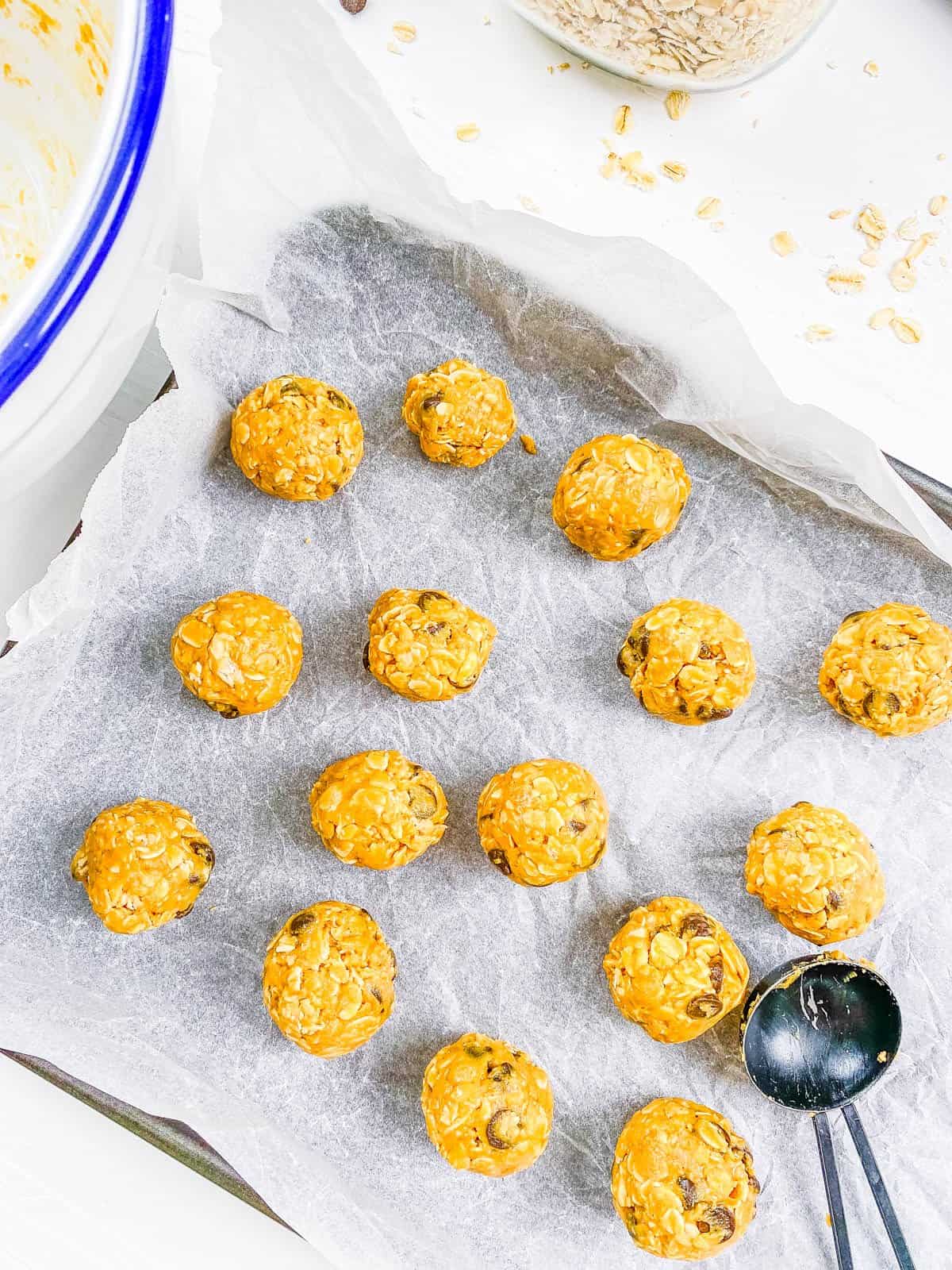
My #1 Secret Tip for this recipe is to make sure you measure ingredients precisely, with the right ratio of wet to dry ingredients.
While there is a little wiggle room with these bliss balls due to them being a no-bake recipe, I recommend being precise with all measurements to ensure ensures that the mixture has the right consistency to hold together without being too sticky or crumbly.
The creamy peanut butter is critical as the binding ingredient for these bliss balls, and I find it to be especially important to measure correctly. Too much or too little will throw the whole recipe off, leading to a mixture that is either too wet and sticky or too dry and crumbly.
After trial and error, I have found that achieving this balance is important for forming perfect bliss balls that stay intact and have a great texture.
Other Tips To Keep In Mind:
- Use The Right Tools: I like to use a cookie scoop to get all of these no-bake bliss balls the same size and to help my hands stay mess free!
- Check The Oats: If you or someone in your family is gluten intolerant, be sure to check the packaging on your oats for gluten-free certification. Some oats can be at risk for contamination with gluten substances.
- Involve The Kiddos: My kids love to help out in the kitchen, and this no-bake recipe is perfect for kids of all ages! They can learn how to measure out ingredients, combine ingredients, and roll the mixture into perfect ball shapes!
- Adjust For Moisture: If the dough seems too wet to mold into balls, consider adding a tablespoon or two of oat flour or almond flour. This will help to firm the mixture up so that it holds its shape and doesn’t stick to your hands.
- Bliss Balls For Kids: If you want to make these as toddler peanut butter balls I recommend reducing or omitting the sugar! You might also want to cut them into smaller bites when serving.
📖 Variations
I’ve perfected a few easy swaps and add-ins for when I’m looking to switch up the taste or texture a bit with these healthy kid-friendly bliss balls. There is something for any occasion! Here are my favorite variations:
Peanut Butter Protein Balls: If you want to turn these peanut butter protein bliss balls, consider adding a scoop of vegan vanilla protein powder to the batter before mixing it. You can use up to 2 scoops of protein powder, depending on the flavor of the protein powder you use. Sometimes I also add 1 tablespoon of ground chia seeds, flax seed, or hemp seeds for an extra boost of protein and healthy fats.
Chocolate Bliss Balls With Peanut Butter: For a double serving of chocolate, add a tablespoon of cacao or cocoa powder to the batter before mixing. I love the rich and indulgent flavor that this gives this recipe! I serve this as a healthy kids dessert often!
Peanut Butter Date Bliss Balls: For a sweeter flavor, I like to add a ¼ cup of Medjool dates, soaked and drained. I use a food processor when adding dates so that they are completely incorporated with the peanut butter and oats.
Sugar-Free Bliss Balls: If you want to make these no-bake peanut butter balls truly sugar-free, you can omit the maple syrup and use sugar-free chocolate. I think they still taste pretty good thanks to the natural sweetness from the vanilla and chocolate chips! If you are making these peanut butter balls for toddlers, this is a good option.
Mix-Ins: Add your favorite mix-ins to give these peanut butter energy balls some texture. I find that crushed walnuts, pecans, peanuts, sunflower seeds, and cacao nibs work really well in this recipe. My other favorites are dried fruit like cranberries, raisins, dried apricots, and shredded coconut. I also love adding spices like a pinch of sea salt, cinnamon powder, nutmeg, or pumpkin pie spice into the mixture. When making these as toddler protein balls, be mindful of the size of the nuts and dried fruit.
🍽 Serving Suggestions
While I love these healthy bliss balls with peanut butter on their own for an easy grab-and-go snack or healthy dessert, it can be so fun to get creative with other ways to serve these! Try some of these ideas:
Toppings: For a decadent dessert I love to drizzle chocolate sauce or caramel sauce (like the one on this no-bake salted caramel cheesecake) over these no bake snacks!
Ice Cream: My kids love to mix these no bake peanut butter dessert balls into tofu ice cream for a delicious treat.
Drinks: Energy balls can be found at a lot of coffee shops nowadays, so it only feels right to create those coffee shop vibes at home! I have been loving these balls with my oatmilk honey latte or iced ube latte! You can also do a creamy mixed berry smoothie alongside these protein balls for kids as an afternoon snack.
With Other Energy Bites: Make a spread of energy bites and serve these alongside my vegan protein balls, peanut butter date balls, and these homemade lara bars! I love this idea for parties and special occasions!
🫙 Storage Instructions
Room Temperature: I store these dairy free peanut butter balls in an airtight container at room temperature for up to 3 days.
To Refrigerate: After placing in an airtight container or resealable plastic bag, I’ll store these in the fridge for maximum freshness. They’ll be good for about one week!
Freezer: I don’t recommend storing these vegan energy balls in the freezer as they won’t taste as good when defrosted.
❓Recipe FAQs
The best type of peanut butter to use is natural peanut butter with no added sugars, oils, or preservatives. I recommend looking for a brand that has just one ingredient listed: peanuts. You can also use a brand that has peanuts and salt listed as the only two ingredients.
There are two ways I’d recommend adjusting this recipe if your mixture is too dry: 1) Add more peanut butter – it’ll help bind the ingredients and add moisture. 2) Add a little bit of coconut oil, maple syrup, or even a touch of applesauce – these ingredients will add moisture and flavor to your peanut butter oat balls!

Want to Save This Recipe?
Enter your email & I’ll send it to your inbox. Plus, get great new recipes from me every week!
By submitting this form, you consent to receive emails from The Picky Eater.
Love this plant based dessert recipe? Please leave a 5-star rating 🌟 in the recipe below and/or a review in the comments section further down the page!
You can also FOLLOW ME on FACEBOOK, INSTAGRAM, and PINTEREST to see more delicious, healthy, family-friendly food, and if you have any questions, I’m here to help!
📋 Recipe Card
Healthy No-Bake Peanut Butter Bliss Balls
My healthy, easy no bake peanut butter bliss balls are loaded with creamy peanut butter and chocolate flavor, making them a hit with both kids and adults alike. Enjoy these as an on-the-go breakfast, wholesome snack, or healthy dessert alternative! They’re also dairy-free, vegan, gluten-free, and low in sugar, making them ideal for a variety of dietary preferences.
Servings: 16 balls
Calories: 93kcal
-
In a large bowl, using a wooden spoon, stir together the oats, peanut butter, chocolate chips, maple syrup, vanilla, salt (and protein powder, if using) until combined.
-
Line a baking sheet with parchment paper.
-
Taking small handfuls of the mixture, roll them into small balls 1-2 inches in size. Or you can use a cookie scoop. Place them onto the baking sheet.
-
Refrigerate the bites for 30 minutes or until solid. Store in an air-tight container in the fridge (they will last at least 1 week, and likely 2!)
- Use The Right Tools: Use a cookie scoop to get all of the balls the same size.
- Check The Oats: If you or someone in your family is gluten intolerant, be sure to use gluten-free oats.
- Involve The Kiddos: This is such a great no bake recipe for kids to make – get them in the kitchen!
- Adjust For Moisture: If the dough seems too wet to mold into balls, consider adding a tablespoon or two of almond flour.
- Sugar Free: If you want to make these truly sugar-free, you can omit the maple syrup, and they will still taste pretty good.
- Peanut-Free: Use your favorite alternative nut butter or seed-based butter.
- Nutritional information includes protein powder. Note: for even more protein, use 1 scoop of vegan vanilla protein powder and 1 scoop of peanut butter protein powder.
Serving: 1ball | Calories: 93kcal | Carbohydrates: 8g | Protein: 4g | Fat: 5g | Saturated Fat: 2g | Polyunsaturated Fat: 1g | Monounsaturated Fat: 2g | Cholesterol: 4mg | Sodium: 43mg | Potassium: 92mg | Fiber: 1g | Sugar: 3g
Health
Federal Experts Talk Bird Flu ‘What Ifs’ in WebMD Live Event

May 16, 2024 – Multiple U.S. agencies are working to contain the recent bird flu outbreak among cattle to prevent further spread to humans (beyond one case reported in early April) and use what we learned before, during, and after the COVID-19 pandemic to keep farm workers and the general public safe.
Fingers crossed, the bird flu will be contained and peter out. Or the outbreak could continue to spread among dairy cattle and other animals, threatening the health and livelihoods of farmers and others who work with livestock.
Or the virus could change in a way that makes it easier to infect and spread among people. If this happens, the worst-case scenario could be a new influenza pandemic.
With so many unknowns, WebMD brought together experts from four federal agencies to talk prevention, monitoring, and what the “what ifs” of bird flu might look like.
Communication with the public “about what we know, what we don’t know, and ways you and your family can stay safe is a priority for us at CDC,” said Nirav D. Shah, MD, JD, the CDC’s principal deputy director. “We at the federal level are responding, and we want the public to be following along.”
People should consult the websites for the CDC, FDA, U.S. Department of Agriculture (USDA), and the Administration for Strategic Preparedness and Response (ASPR) for updates.
It is essential to not only stay informed, but to seek trusted sources of information, Shah said during “Bird Flu 2024 – What You Need to Know,” an online briefing jointly sponsored by the CDC and WebMD.
An ‘Experimental Hamburger’
If one take-home message emerged from the event, it was that the threat to the general public remains low.
The retail milk supply is safe, although consuming raw or unpasteurized milk is not recommended. “While commercial milk supply is safe, we strongly advise against drinking raw milk,” said Donald A. Prater, DVM, acting director for the FDA’s Center for Food Safety and Applied Nutrition.
As for other foods, thoroughly cooked eggs are less risky than raw eggs, and the nation’s beef supply remains free of the virus as well.
For years, federal inspectors have purchased and tested meat at retail stores, said Eric Deeble, DVM, USDA deputy assistant secretary for the Office of Congressional Relations. So far, H5N1, the virus behind bird flu, has not been detected in beef.
The USDA took testing a step further and recently cooked ground beef from dairy cows in their lab. Using what Deeble described as an “experimental hamburger,” the agency showed cooking beef to 165 F or higher kills the virus if it ever becomes necessary.
The federal government now requires all cattle be tested and be free of bird flu virus before crossing any state lines. The government is also reimbursing farmers for veterinary care and loss of business related to the outbreak, and supply personal protective equipment (PPE) like gloves, masks, and face shields to workers.
Vaccination Not Recommended Now
Federal scientists know enough about H5N1 virus to create vaccines against it quickly if the need arises. It’s more about planning ahead at this point. “Vaccines are not part of our response right now,” said David Boucher, PhD, director of infectious diseases preparedness and response at the Administration for Strategic Preparedness and Response.
If the virus changes and becomes a bigger threat to people, “we have the building blocks to produce a vaccine,” Boucher added.
An event attendee asked if the seasonal flu shot offers any protection. “Unfortunately, the flu shot you got last year does not provide great protection from the avian flu,” Shah responded. “It might do a little bit … but that is the vaccine for seasonal flu. This is something more novel.”
Treatments Stockpiled and Ready
Antiviral medications, which if given early in the course of bird flu infection could shorten the severity or duration of illness, are available now, Shah said. The dairy farmer who was infected with bird flu earlier this year responded to oseltamivir (Tamiflu) treatment, for example.
When it comes to bird flu symptoms, the fact that the only infected person reported so far this year developed pink eye, also known as conjunctivitis, is interesting, Shah said. Officials would have expected to see more typical seasonal flu symptoms, he added.
“Influenza is not a new virus,” Boucher said. “With this strain of influenza, we are not seeing any genetic markers associated with resistance to antivirals. That means the antivirals we take for seasonal influenza would also be available if needed to treat H5N1.”
ASPR has stockpiled Tamiflu and three other antivirals. “We do have tens of millions of courses that can be distributed around the country if we need them,” he added.
“Influenza is an enemy we know well,” Boucher said. That is why “we have antivirals ready to go now and many types of PPE.”
Science in Action
The feds intend to stay on the case. They will continue to monitor emergency department visits, lab test orders, and wastewater samples for any changes suggesting a human pandemic risk is growing.
“While we’ve learned a great deal, there are still many things we do not know,” Deeble said.
Shah added, “As in any outbreak, this is an evolving situation and things can change. What you are seeing now is science in action.”
For the latest updates on bird flu in the United States, visit the CDC’s H5N1 Bird Flu: Current Situation Summary website.
-

 African History4 months ago
African History4 months agoBlack History Facts I had to Learn on My Own pt.6 📜
-

 African History4 years ago
African History4 years agoA Closer Look: Afro-Mexicans 🇲🇽
-

 African History1 year ago
African History1 year agoPROOF AFRICAN AMERICANS AIN'T FROM AFRICA DOCUMENTED EVIDENCE
-

 African History2 years ago
African History2 years agoHow Did Normal Medieval People Survive Winter? | Tudor Monastery Farm | Chronicle
-

 African History4 years ago
African History4 years agoA Closer Look: Afro-Mexicans 🇲🇽
-

 African History3 years ago
African History3 years agoThe Entire History of Africa in Under 10 Minutes – Documentary
-

 African History3 years ago
African History3 years agoWhat happened to the many African Kingdoms? History of Africa 1500-1800 Documentary 1/6
-

 African History2 years ago
African History2 years agoAFRO MEXICO: Black History In Mexico!

